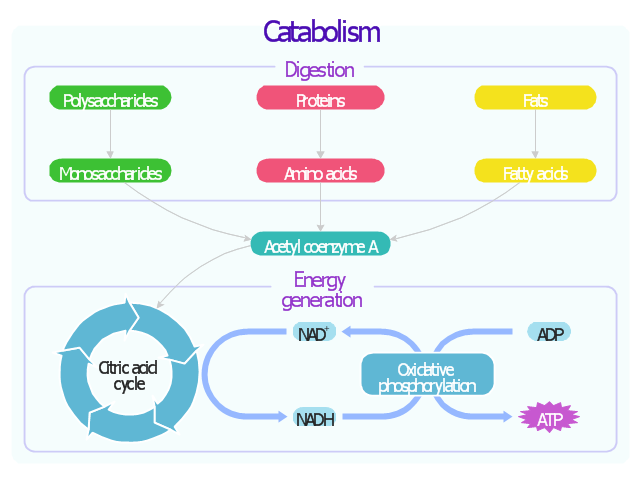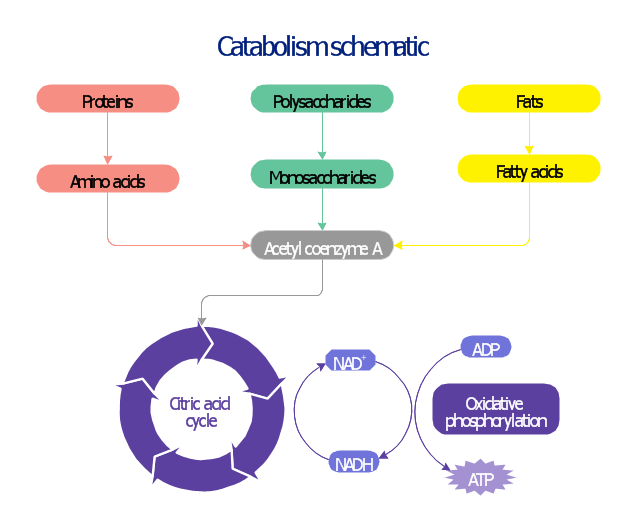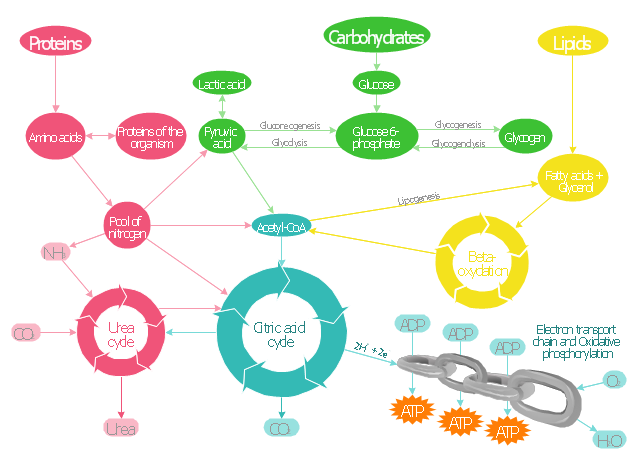Citric acid cycle (tricarboxylic acid cycle, TCA cycle, Krebs cycle) is a series of chemical reactions used by all aerobic organisms to generate energy through the oxidation of acetate derived from carbohydrates, fats and proteins into carbon dioxide and chemical energy in the form of adenosine triphosphate (ATP). [Citric acid cycle. Wikipedia] This biochemical schematical diagram example shows metabolic pathways map of citric acid cycle reactions. This sample was redesigned using ConceptDraw PRO digramming and vector drawing software from the Wikimedia Commons file TCA cycle.svg [https:/ / commons.wikimedia.org/ wiki/ File:TCA_ cycle.svg ]. This image is licensed under the Creative Commons Attribution 3.0 Unported license [https:/ / creativecommons.org/ licenses/ by/ 3.0/ deed.en ].
This biochemistry diagram example is included in the Biology solution from the Science and Education area of ConceptDraw Solution Park. [ www.conceptdraw.com/ solution-park/ science-education-biology ]
In biochemistry, metabolic pathways are series of chemical reactions occurring within a cell. In each pathway, a principal chemical is modified by a series of chemical reactions. Enzymes catalyze these reactions, and often require dietary minerals, vitamins, and other cofactors in order to function properly. Because of the many chemicals (a.k.a. "metabolites") that may be involved, metabolic pathways can be quite elaborate. In addition, numerous distinct pathways co-exist within a cell. This collection of pathways is called the metabolic network. Pathways are important to the maintenance of homeostasis within an organism. Catabolic (break-down) and Anabolic (synthesis) pathways often work interdependently to create new biomolecules as the final end-products. [Metabolic pathway. Wikipedia]
This metabolic pathway map example was created using ConceptDraw PRO diagramming and vector drawing software extended with Biology solution from Science and Education area of ConceptDraw Solution Park.
https:/ / www.conceptdraw.com/ solution-park/ science-education-biology
Simplified diagram of catabolism of proteins, carbohydrates and fats.
This biochemical chart display how proteins, polysaccharides and fats from food are digested into gastrointestinal tract into aminoacids, monosaccharides and fatty acids, and then broken down and oxidized to carbon dioxide and water in cellular processes of energy generation.
This metabolic pathway map was redesigned using ConceptDraw PRO diagramming and vector drawing software from Wikipedia file Catabolism schematic.svg [https:/ / en.wikipedia.org/ wiki/ File:Catabolism_ schematic.svg].
This biochemistry diagram example is included in the Biology solution from the Science and Education area of ConceptDraw Solution Park. www.conceptdraw.com/ solution-park/ science-education-biology
Metabolism is refer to all chemical reactions that occur in living organisms, including digestion and the transport of substances into and between different cells. Metabolism is usually divided into catabolism, that breaks down organic matter and harvests energy by way of cellular respiration, and anabolism that uses energy to construct components of cells such as proteins and nucleic acids.
The chemical reactions of metabolism are organized into metabolic pathways, in which one chemical is transformed through a series of steps into another chemical, by a sequence of enzymes. [Metabolism. Wikipedia]
This example was created using ConceptDraw PRO diagramming and vector drawing software extended with Biology solution from Science and Education area of ConceptDraw Solution Park.
https:/ / www.conceptdraw.com/ solution-park/ science-education-biology
- Citric acid cycle ( TCA cycle ) | Biochemical metabolic pathway map ...
- Citric acid cycle ( TCA cycle ) |
- LLNL Flow Charts | Manufacturing and Maintenance | Citric acid ...
- Biology | Bio Flowchart Lite | Glucose catabolism pathways map |
- Drawing a Nature Scene | Drawing Illustration | Water Cycle |
- Drawing Illustration | Drawing a Nature Scene | Water Cycle |
- Glycolysis overview diagram | Catabolism schematic | Glucose ...
- Physics | Language Learning | Astronomy |
- Business Diagram Software | Physics | ConceptDraw Arrows10 ...
- Conventional energy resources | Resources and energy vector ...
- Catabolism schematic | Design elements - Biochemistry of metabolism
- Chemistry | Design elements - Chemical elements | Carbonyl ...
- Business Diagram Software | Org chart - University | Business ...
- Design elements - Biochemistry of metabolism | Business Diagram ...
- Chemical and Process Engineering | Engineering | Process flow ...
- Design elements - Chemical drawings | Chemistry | Engineering |
- Biochemical pathway map - Key metabolic processes |
- Network Diagram Examples | Cisco Network Design | 3D Network ...
- What can you create with ConceptDraw MINDMAP? | SWOT ...
- Biochemical pathway map - Key metabolic processes | Design ...
- ERD | Entity Relationship Diagrams, ERD Software for Mac and Win
- Flowchart | Basic Flowchart Symbols and Meaning
- Flowchart | Flowchart Design - Symbols, Shapes, Stencils and Icons
- Flowchart | Flow Chart Symbols
- Electrical | Electrical Drawing - Wiring and Circuits Schematics
- Flowchart | Common Flowchart Symbols
- Flowchart | Common Flowchart Symbols
.png--diagram-flowchart-example.png)


